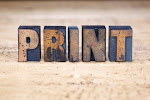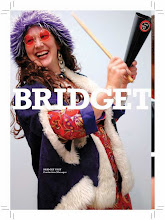Great video! Well designed and effectively communicates the pros of social media.
Wednesday, August 26, 2009
Tuesday, August 11, 2009
Is it a HORROR FLICK with a TWIST of ROMANCE??? Nope, it's just design & printing terminology.
• BLEED • DIE • SCORE • KISS CUT • SPREAD • TRIM • TIP IN • LIVE AREA •
Visions of a slasher movie with a romantic twist come to mind... but alas, it's just design and printing terminology.
In every industry, there exists terminology specific to that business. In design and production, there’s no exception. I thought it would be helpful to share some of the basic definitions here, for designers who are just getting started. Not a terribly exciting topic but relevant nonetheless. Bookmark this page for reference, and refer to it as these familiar terms cross your plate in the future.
SPECS—LIVE AREA—BLEED—TRIM
Typically, creative directors, publishers, and sometimes printers (depending on the project), provide designers with specifications for their projects. These SPECS (for short) typically include what are referred to as the LIVE AREA and the BLEED. The LIVE AREA refers to the space the design must be contained in. The BLEED is the intentional continuance of the design beyond the live area (usually about .125” on all sides). Bleed is an important element of designs that go all the way to the edge of the paper. It is incorporated because the printer TRIMS (aka cuts) the design to the desired size (live area) once the item is reproduced, removing the extra .125" of bleed for a clean and gorgeous end product.
SPREAD
A SPREAD consists of two pages that face each other and are designed as one visual or production unit.
The following items refer primarily to finishing techniques or items you might specify when estimating a print job.
4 COLOR PROCESS or PROCESS COLORS vs. PANTONE or SPOT COLORS
See my blog entry from May 18, 2009 for the differences between specifying 4CP/CMYK vs. Spot Color/PMS. http://concoctionconspirator.blogspot.com/2009/05/cmyk-vs-pms.html
AQUEOUS vs. VARNISH COATINGS
I couldn’t have said it better myself. For more information on these items, please refer to this link, with an article on the pros and cons/differences. http://www.printindustry.com/newsletter_18.htm
SCORE/SCORING
Scoring simply refers to paper or card stock that has been compressed along a straight line (either by a machine or by hand) so it folds easily and accurately.
DIE/DIE CUTTING
Think of custom packaging, jigsaw puzzles, and stickers—anything with a customized shape. A DIE cuts, scores, stamps, embosses and debosses printed items. DIE CUTTING occurs when the die is utilized to cut or impress irregular shapes in paper, stickers, labels, or paperboard.
KISS CUTTING
KISS CUTTING is when you die cut through a peel n' stick sheet, applying just enough pressure so the die slices through the adhesive, but not through the back of the sheet. This enables the user to pull stickers off one at a time from the larger intact sheet.
TIP IN
A TIP IN is an extra page or design feature that is added to a printed piece beyond the normal process. It can be applied as a novel design adaptation and may be created using the same or different paper than the original printed design. In one of the pieces we’re currently working on, we are tipping in actual photographs to show the range of a particular product.
SADDLE STITCH
SADDLE STITCHING is a binding technique for multi-page printed pieces. Essentially, it means that the item is bound using staples (typically 3). For smaller creations, this is a cost-effective means of binding. Designs must be created in 4-page increments (8, 12, 16, 20, 24, etc…) up to a certain maximum size—dependent upon your paper choice.
PERFECT BOUND
PERFECT BINDING is also a binding technique for multi-page printed pieces. When requesting perfect binding, please note that your design must be a minimum number of pages (approximately 24+, depending on the weight of the paper). One of the benefits of perfect binding is that you do not have to create your document in 4-page increments. The pages are glued on the edge and can accommodate odd numbered pieces. Books are typically perfect bound.
For today, I’ll stop here. The world of print production is filled with nomenclature that, I admit, can become overwhelming at times. This basic list will have you sounding like a pro in no time flat. ;~)
Tuesday, August 4, 2009
Color Inspired Typography
One of my co-workers sent me the link to this amazing website where you can search typography by color. It's pretty cool—anyone can upload a photo if you have an online link to it. The site reminded him of our Urban Inspiration project. I was inspired to submit my "PLEASE LET DOWN EASY" shot. Here are some screen grabs to inspire you too!

http://welovetypography.com






http://welovetypography.com





Subscribe to:
Posts (Atom)




